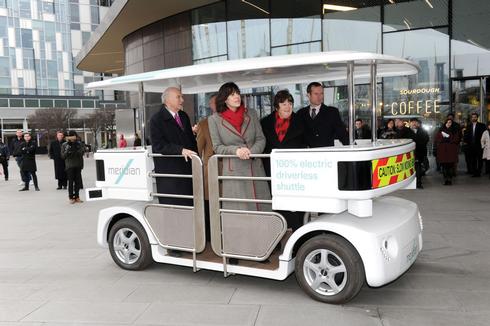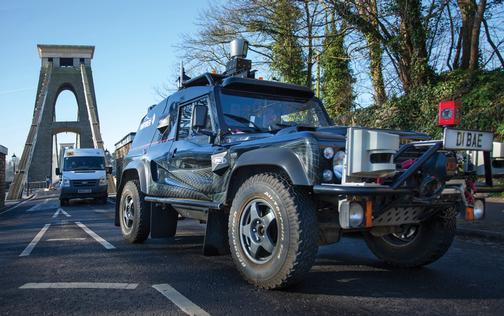


The Government is currently trialing ‘driverless car’ technology in three projects in Bristol, Coventry/Milton Keynes and the London borough of Greenwich, but the most interesting aspect of the trials is the fact that it is not the technology itself that is the main focus. “It is all about perception and acceptance,” says Iwan Parry, project manager of the GATEway trial in Greenwich being led by TRL. “It is not about new technologies, it is about how they will integrate [with the current state of play]. It is about sentiment analysis, about finding ways to evaluate how driverless shuttles will behave when operating in an ‘unconstrained’ environment.”
What this means is that the GATEway trial will involve a driverless shuttle operating on a loop route between North Greenwich Tube station and the O2 entertainment complex in an off-road environment but one where there will often be large numbers of pedestrians milling around in the path of the driverless vehicle. “There are potentially major road safety benefits,” Parry says. “But there is a need for an independent assessment of the potential unintended consequences.”
The GATEway project (Greenwich Automated Transport Environment) is one of three projects awarded to test ‘driverless’ vehicles in UK urban locations. The £8m programme will see three trials of different types of zero-emission automated vehicles within a ‘technology-agnostic’ testing environment.
The purpose of the programme is to demonstrate automated transport systems to public, industry and media stakeholders. These will include various public tests of fully automated passenger shuttle transport systems and autonomous valet parking for adapted cars.
In addition to the on-street trials in Greenwich, TRL’s driving simulator, DigiCar, will be used in parallel to investigate driver behaviour with automated vehicles using a 3D model of the Greenwich peninsula. “Risk, liability and insurance issues will be specifically addressed whilst pedestrian models of interaction with automated vehicles will be developed alongside exploration of adaptation to traffic lights to enable safe and effective automated vehicle operation,” TRL says.
The automated vehicle technology to be tested in Greenwich will be provided by Phoenix Wings, a company that has been involved in worldwide demonstrations of automated transport. Crowd-sourcing specialists Commonplace will use digital and social media tools to map public responses to the trial whilst additional vehicle adaptation and robotics expertise will be provided by GOBOTiX.
The emphasis on the social, and legal, aspects of autonomous vehicles in the trials is also emphasised by the UK Autodrive consortium led by Arup. “Not only will the programme help develop the new protocols and connected infrastructure required to deliver future autonomous mobility, it will allow the UK Autodrive team to test public reaction to both driverless cars and self-driving pods,” an Arup spokeswoman says. UK Autodrive will deliver a programme of feasibility studies and practical demonstrations in Milton Keynes and Coventry, where the city councils are taking the lead in developing the urban infrastructure technologies required to support xxdriverless mobility.
The feasibility studies will consider the significant implications and challenges of introducing autonomous vehicles from a technical, social and economic perspective. The studies will provide insights for vehicle manufacturers, cities, commercial operators, legislators and insurers to develop the legal framework for the roll-out of autonomous mobility. On-road testing will include the real-world evaluation of passenger cars with increasing levels of autonomy, as well as the development and evaluation of lightweight fully autonomous self-driving pods designed for pedestrianised spaces.
In Bristol, meanwhile, the VENTURER consortium has secured funding to test driverless cars in the Bristol region. VENTURER is made up of organisations in the South West that include Atkins, Bristol City Council, South Gloucestershire Council, AXA, Williams Advanced Engineering, Fusion Processing, Centre for Transport and Society, University of the West of England (UWE Bristol), University of Bristol and Bristol Robotics Laboratory, a collaboration between the University of Bristol and UWE Bristol.
Lee Woodcock, VENTURER project lead and technology director for Atkins’ Highways & Transportation business, says: “The VENTURER consortium will be exploring the feasibility of driverless cars in the UK by trialing autonomous vehicles in the Bristol region, investigating the legal and insurance aspects of driverless cars and exploring how the public react to such vehicles.
“This programme will help to deepen our understanding of the impact on road users and wider society and open up new opportunities for our economy and society.”
Professor Graham Parkhurst, director of the Centre for Transport and Society at the University of the West of England, notes that: “The possibility of driverless cars running in city centres presents some important challenges for how we manage the interactions of people and vehicles. Pedestrians will still want the freedom to cross the road where it suits them, but driverless cars will need to be able to make progress safely if they are to be effective. Driverless cars also have a large potential to change both our travel patterns, and what we do while we travel. Will travellers be able to read a book in urban traffic, or will they feel too travelsick? More people could travel by car if they don't need a licence themselves or someone to drive them. This could open up opportunities to people but might also mean more car traffic. On the other hand, cars driven automatically are expected to be more energy efficient than when driven by the typical human, and people might be more willing to share if nobody is taking the responsibility for the driving. So a key challenge is to understand how far driverless cars will be a good or bad development in environmental terms.”
Anthony Pipe, professor of robotics and autonomous systems at UWE, observes that the current trials of driverless cars, could have “far-reaching societal and economic benefits. One of the legacies of our programme will be to create a uniquely valuable vehicle testing facility by utilising the specialised knowledge of our consortium, including integrated city-wide advanced communications systems, real and simulated vehicle platforms, robot technology and controlled access to public roads. Those wishing to use this facility will be able to thoroughly test their new technology or related socio-economic benefits.”
Cyber security
Much of the current research is intended to determine whether the state-of-the-art automotive technology, which, on paper, should make our roads safer, will actually do so. And the Institution of Engineering and Technology (IET), for one, is by no means convinced that this will automatically be the case. Hugh Boyes, the IET’s cyber security lead, warns that software systems must become far more reliable before the public and the Government can have confidence in vehicles that are largely computer-controlled.
“A recent report found that 98 per cent of software applications tested had serious defects – some with 10 to 15 faults each,” Boyes points out. “And, while car manufacturers make a considerable effort to make their products as safe as possible, the danger from hacking is simply not on their radar. We need to ensure that these vehicles don’t have this level of defect. That’s quite a challenge given the nature of the modern vehicle. If we have the hacker community start to target vehicles, we can imagine a fair amount of chaos. We just have to look at what happens in London when one vehicle breaks down on a major artery into the city; the tailbacks that rapidly occur. If just one in a 100 vehicles, or one in 1,000, gets interfered with and ceases to operate as planned we can expect chaos on the roads. We don't want to be there. That is why cyber-security of autonomous vehicles will be critical.”
Boyes therefore notes that ‘driverless’ cars will need to be equipped with ‘black box’ recorders to prevent intractable legal arguments between insurers about who was to blame for an accident, the driver or the software.
“We don’t have the strict product liability for software as we do for hardware,” he says. “For autonomous vehicles, that’s going to have to change, because they are cyber-physical systems. They are a combination of IT and hardware.”
The consensus, however, seems to be that driverless cars will probably reduce the number of serious road traffic accidents. Nick Reed, principal human factors researcher at TRL, for example, observes that: “Are they going to be safer than human drivers? There’s a long way to go before that can be proved but we know that human error is a contributory factor in a lot of collisions.”
Professor Phil Blythe, chair of the IET’s transport policy committee, concurs. “There are clear safety benefits in getting vehicles to drive optimally and at a particular speed while interacting with the infrastructure,” he says. “We’re moving towards co-operative systems. The first trial began in the UK in January. Vehicles and traffic lights will be talking to each other – that’s the first step.”

TransportXtra is part of Landor LINKS
© 2024 TransportXtra | Landor LINKS Ltd | All Rights Reserved
Subscriptions, Magazines & Online Access Enquires
[Frequently Asked Questions]
Email: subs.ltt@landor.co.uk | Tel: +44 (0) 20 7091 7959
Shop & Accounts Enquires
Email: accounts@landor.co.uk | Tel: +44 (0) 20 7091 7855
Advertising Sales & Recruitment Enquires
Email: daniel@landor.co.uk | Tel: +44 (0) 20 7091 7861
Events & Conference Enquires
Email: conferences@landor.co.uk | Tel: +44 (0) 20 7091 7865
Press Releases & Editorial Enquires
Email: info@transportxtra.com | Tel: +44 (0) 20 7091 7875
Privacy Policy | Terms and Conditions | Advertise
Web design london by Brainiac Media 2020